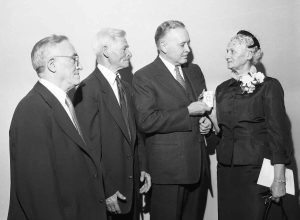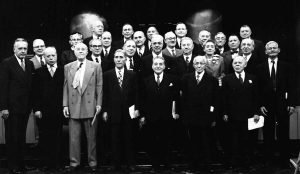In 1954, Columbia marked its first 200 years with a year-long celebration. There were conferences, convocations, a weekly radio show, a commemorative US postage stamp, and a very special reception dedicated to the long-term Morningside Heights neighborhood businesses. From Queen Elizabeth, the Queen Mother, attending the Charter Day Dinner to John Courtsounis, the peanut vendor on 116th Street and Broadway, receiving a medallion for his 46 years of service, all of the records documenting the Columbia Bicentennial anniversary have been processed and now available to researchers.

In 1954, a special faculty committee set out first to define Morningside Heights (110th to 122nd Street, between Morningside and Riverside Drives) and then to identify the persons operating retail businesses in the area. They interviewed over 265 individuals, proprietors and employees, including tailors, grocers, florists, laundry operators, barbers, vendors, etc. They wanted to know how long they had been Columbia’s neighbors. The completed surveys, a great snapshot of the neighborhood in 1954, are part of the Columbia Bicentennial Anniversary records and are organized by the merchant’s tenure in the area: from 0 to 5 years, all the way to 35 years and more. The twenty-six longest serving neighbors were then invited to a Special Reception at Low Library on a Sunday afternoon in December 1954. Each of the long-term neighbors was paired with a faculty escort, who welcomed them and took them to the President’s Office to sign the Bicentennial guestbook (also in the collection). During the ceremony, the loyal neighbors were presented with a certificate of appreciation marking their faithful service and a Bicentennial medallion engraved with their name.

This is just one of the many events during the Bicentennial year that are well documented in the Columbia Bicentennial anniversary records. There are conference transcripts and papers, press releases, newspaper clippings, invitations, programs, and all of the records from the specially created Bicentennial Office: correspondence files, office files and even subject files, which were assembled in 1955 as the events had concluded. This collection goes hand in hand with the RBML’s Columbia University Bicentennial Collection, 1946-1957, which also recently got an updated finding aid. This associated collection includes audiovisual materials, the Office of Development records, Bicentennial greetings from around the world, and related printed materials such as books, pamphlets, and newsletters.